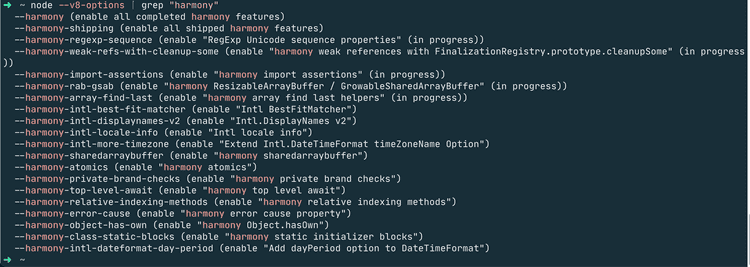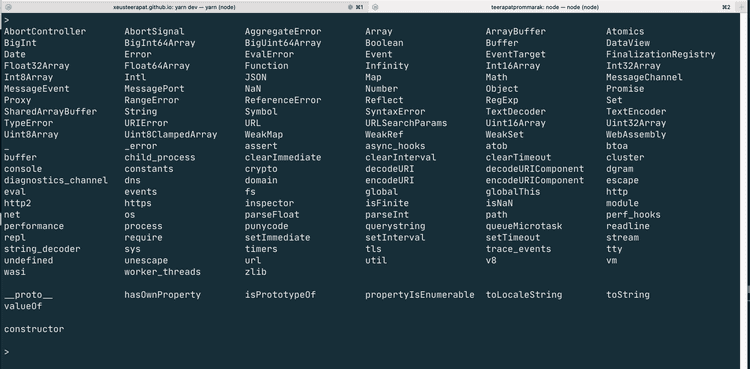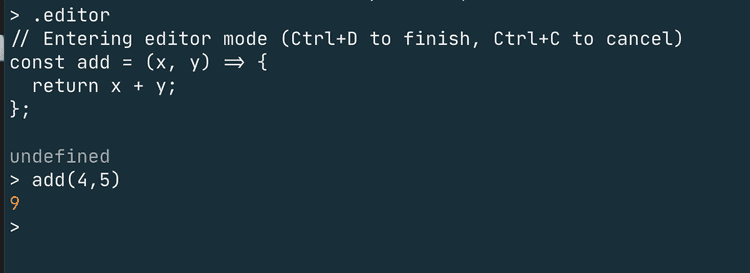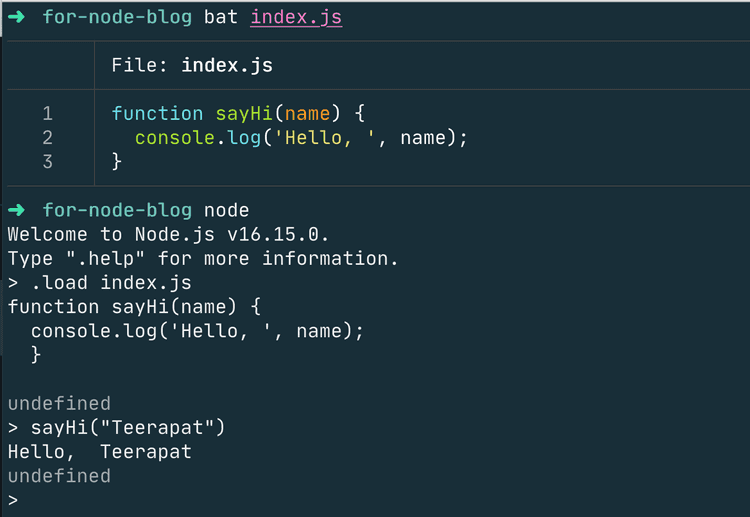Hello, World
Interesting Node.js Core Concepts
2022-05-14
I have been using Node.js for around 2-3 years. Most of the time is about building REST API or GraphQL API. Every project uses Node.js libraries a lot to help the team bootstrapping the project easily and quickly. Sometimes I feel like I jumped into building the API too quickly, instead of understanding its internal core concept first. Today, I just finished the Advanced Node.js from Pluralsight taught by Samer Buna and I found many interesting topics I would like to share to other people. I think it would be great if you learn these concept of Node.js before building the REST API from other courses or tutorials. I also recommend you check out this course (no affiliate)
Node.js and Javascript Engine
As you already known, Node.js runs on the V8 engine give us an ability to execute Javascript code outside the browser. But actually, V8 is just a one options from many. Node.js also can use other Javascript engine as a VM like node-chakracore. Unfortunately, this project seems no longer active anymore.
you can use command node --v8-options to list the options features from V8 engine. Here I list all --harmony flag, which means you need to provide --harmony flag in order to get these features work.

REPL
You might have played around with the REPL after you installed Node.js on your machine. It give us a convenience way to interact with Javascript in the terminal. Here are some useful tips when you use the REPL in Node.js
Auto-Complete
You can double press Tab button to list all global objects in Node.js

It also works on any object in Node.js as well, such as http. and double press Tab
> http.
http.__proto__ http.constructor http.hasOwnProperty http.isPrototypeOf
http.propertyIsEnumerable http.toLocaleString http.toString http.valueOf
http.Agent http.ClientRequest http.IncomingMessage http.METHODS
http.OutgoingMessage http.STATUS_CODES http.Server http.ServerResponse
http._connectionListener http.createServer http.get http.globalAgent
http.maxHeaderSize http.request http.validateHeaderName http.validateHeaderValueYou can access to the last evaluated value by using the _ variable and also can assign to another variable too.
> Math.random()
0.7172339982201723
> _
0.7172339982201723
> let lastVal = _
undefined
> lastVal
0.7172339982201723The special commands in Node.js REPL is . (dot), if you type command . and press double Tab
> .
break clear editor exit help load saveIf you type command .help and enter it will list all commands above with its description
> .help
.break Sometimes you get stuck, this gets you out
.clear Alias for .break
.editor Enter editor mode
.exit Exit the REPL
.help Print this help message
.load Load JS from a file into the REPL session
.save Save all evaluated commands in this REPL session to a file
Press Ctrl+C to abort current expression, Ctrl+D to exit the REPLYou can use .editor to enter the editor mode that give you the multi-line editor in the REPL and press ctrl+D when you done. You can learn more REPL in official documentation.
> .editor
// Entering editor mode (Ctrl+D to finish, Ctrl+C to cancel)
const add = (x, y) => {
return x + y;
};

You can load the Javascript file into the REPL using .load command

Global Object, Process, and Buffer
You can use global objects in Node.js without using the require keyword. One of the most important global object is process so, let's talk about it
Process
The process object provides information about, and control over, the current Node.js process application and its environment. You most you use in Node.js app is might be process.env to manage user environment. Here are some other useful properties of process object
You can use process.versions to list all version numbers and its dependencies
> process.versions
{
node: '18.12.1',
v8: '10.2.154.15-node.12',
uv: '1.43.0',
zlib: '1.2.11',
brotli: '1.0.9',
ares: '1.18.1',
modules: '108',
nghttp2: '1.47.0',
napi: '8',
llhttp: '6.0.10',
openssl: '3.0.7+quic',
cldr: '41.0',
icu: '71.1',
tz: '2022b',
unicode: '14.0',
ngtcp2: '0.8.1',
nghttp3: '0.7.0'
}You can use process.release to get the label of your Node.js version in your machine.
> process.release
{
name: 'node',
lts: 'Hydrogen',
sourceUrl: 'https://nodejs.org/download/release/v18.12.1/node-v18.12.1.tar.gz',
headersUrl: 'https://nodejs.org/download/release/v18.12.1/node-v18.12.1-headers.tar.gz'
}The process object is an instance of the Event Emitter so you can listen to specific events on the process
// process object
process.on('exit', code => {
// do one final synchronouse operation
// before the node process terminates
console.log(`About to exit with code ${code}`);
});
process.on('uncaughtException', err => {
// something went wrong and unhandle
// clean up and exit
console.error(err);
process.exit(1);
});
// keep the event loop running
process.stdin.resume();
// trigger a ReferenceError exception
notExistFunc();TODO Process จะกลับมาอธิบายใหม่

Buffer
The Buffer class is heavily use in Node.js in order to work with the binary streams of data. When converting between Buffers and strings, a character encoding may be specified. If no character encoding is specified, UTF-8 will be used as the default. The Buffer is a lower-level data structure to represent a sequence of binary data that cannot be resized when Buffer is allowcate.
const { Buffer } = require('buffer');TODO Buffer จะกลับมาอธิบายใหม่ with String decoder
Require Function
require is a must understanding how it works in Node.js module. To execute the require call, Node.js goes through the following sequence of steps:
- Resolving: Find the absolute file path of a module.
- Loading: Determined by the content of the file at the resolved path.
- Wrapping: Gives every module in its private scope, and makes
requirelocal to every module. - Evaluating: Excute the code.
- Caching: When
requirethe same module, we don't need to go over all steps again.
Here are what you will get when console.log(module); in Javascript file
Module {
id: '.',
path: '/Users/teerapatprommarak/Project/nodejs/for-node-blog',
exports: {},
filename: '/Users/teerapatprommarak/Project/nodejs/for-node-blog/module.js',
loaded: false,
children: [],
paths: [
'/Users/teerapatprommarak/Project/nodejs/for-node-blog/node_modules',
'/Users/teerapatprommarak/Project/nodejs/node_modules',
'/Users/teerapatprommarak/Project/node_modules',
'/Users/teerapatprommarak/node_modules',
'/Users/node_modules',
'/node_modules'
]
}